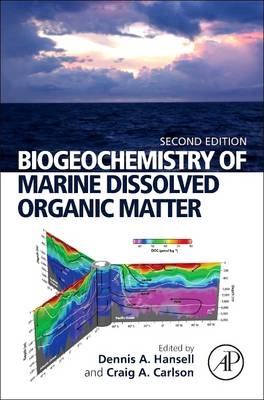
Biogeochemistry of Marine Dissolved Organic Matter
Academic Press Inc (Verlag)
978-0-12-810041-7 (ISBN)
- Titel wird leider nicht erscheinen
- Artikel merken
Presented by some of the world's leading scientists, this revised edition reports on the major advances in this area and includes new chapters covering the role of DOM in ancient ocean carbon cycles, the long term stability of marine DOM, the biophysical dynamics of DOM, fluvial DOM qualities and fate, and the Mediterranean Sea. Biogeochemistry of Marine Dissolved Organic Matter, Second Edition, is an extremely useful resource that helps people interested in the largest pool of active carbon on the planet (DOC) get a firm grounding on the general paradigms and many of the relevant references on this topic.
Hansell was raised in the San Francisco Bay Area, receiving a bachelor's degree in biology at Humboldt State University. He was awarded a masters degree in fisheries science at Auburn University and a doctorate in oceanography at the University of Alaska Fairbanks in 1989, with a focus on the nitrogen cycle of subarctic seas. He was awarded postdoctoral opportunities at the Univ. of California, Santa Cruz and at the Univ. of Washington, then built a research laboratory at the Bermuda Institute of Ocean Science (BIOS). In 2001, he was appointed Professor at the Rosenstiel School of Marine and Atmospheric Science (RSMAS) at the University of Miami. Hansell's research on dissolved organic matter, particularly the cycling of carbon through that pool, has been strongly supported by the U.S. National Science Foundation. Research opportunities arose through his involvement with the U.S. Joint Global Ocean Flux (JGOFS) and the World Ocean Circulation Experiment (WOCE) projects. These projects led to research in all of the major ocean basins and several marginal seas. His laboratory has supported oceanic time-series, process studies and ocean basin-spanning surveys (long lines). He continues in these studies today, including the Repeat Hydrography project organized by U.S. CLIVAR. He has published >100 journal articles and chapters on ocean biogeochemistry.Amongst many services, Hansell was chairman of the U.S. Carbon Cycle ScienceSteering Group and chairman of the Division of Marine and Atmospheric Chemistry at RSMAS. He presently serves as a member of the International Scientific Advisory Committee, Centro De Investigacion En Ecosistemas De La Patagonia, Coyhaique, Aysen, Chile, as a member of the Board of Trustees of BIOS, and as a member of the Advisory Board, Florida Center for Ocean Sciences Education Excellence (COSEE). He was elected to give the 2014 Sverdrup Lecture by the Ocean Sciences Section of the American Geophysical Union. Carlson grew up in New England and received his Bachelor's degree from Colby College (Waterville, ME) in 1986 and his Ph.D. from University of Maryland's Horn Point Laboratory in Cambridge MD in 1994. His graduate research focused on microbial ecology and how microbes process dissolved organic matter in open ocean systems. Much of his graduate work was conducted in the Sargasso Sea in conjunction with the Bermuda Atlantic Time-series Study (BATS) site. He moved to the Bermuda Institute for Ocean Science (BIOS) in 1994 for his post doctoral work where he focused on the focused on the biogeochemistry of dissolved organic matter in the oceanic systems of the Southern Ocean and the North Atlantic Subtropical Gyre. In 1996 he joined the faculty of BIOS where he initiated programs in microbial oceanography. In 2001 Carlson accepted a faculty position at the University of California, Santa Barbara where he is now a full professor. Carlson's research interests, supported by the U.S. National Science Foundation, continue to be shaped by an interdisciplinary blend of marine microbiology and organic biogeochemistry. Specifically his research has focused on the role marine microbes play in the cycling of elements through oceanic dissolved organic matter (DOM) and the biogeochemical significance of DOM in the marine carbon cycle. His earlier work demonstrated the importance of DOM in ocean biogeochemistry and carbon export in the ocean and subsequent work showed how microbial processing of DOM affects its quantity and character through time and space. In 2002 received the American Geophysical Union's Ocean Science Early Career Award for his contributions towards the understanding of the ocean carbon cycle. Carlson currently serves as Vice-Chair of the Ocean Carbon Biogeochemistry committee, is the Chair of the Ecology, Evolution and Marine Biology Department at UCSB and is Co-editor of The Annual Reviews of Marine Science. His hobbies include following New England Sports, cycling and wood working.
1. DOM and the Carbon Cycle of Ancient Oceans
2. DOM Composition
3. Production and Consumption Processes
4. Production and Consumption Processes
5. Dynamics of DON
6. Dynamics of DOP
7. DOM, Trace Elements and Isotopes
8. Carbon Isotopic Composition
9. Long-term Stability of Marine DOM
10. Air/Sea Interactions and Photochemistry
11. Biophysical Dynamics
12. Chromophoric DOM Characterization and Sensing
13. Terrigenous DOM Qualities and Fate in the Marine Environment
14. Sediment Pore Waters
15. DOC in the Mediterranean Sea
16. DO in the Ocean Carbon Budget
17. Modeling DOM Biogeochemistry
| Zusatzinfo | Approx. 200 illustrations (200 in full color); Illustrations, unspecified |
|---|---|
| Verlagsort | San Diego |
| Sprache | englisch |
| Maße | 191 x 235 mm |
| Themenwelt | Naturwissenschaften ► Biologie ► Biochemie |
| Naturwissenschaften ► Chemie ► Organische Chemie | |
| Naturwissenschaften ► Geowissenschaften ► Geologie | |
| Naturwissenschaften ► Geowissenschaften ► Hydrologie / Ozeanografie | |
| Technik ► Umwelttechnik / Biotechnologie | |
| ISBN-10 | 0-12-810041-9 / 0128100419 |
| ISBN-13 | 978-0-12-810041-7 / 9780128100417 |
| Zustand | Neuware |
| Haben Sie eine Frage zum Produkt? |
aus dem Bereich


